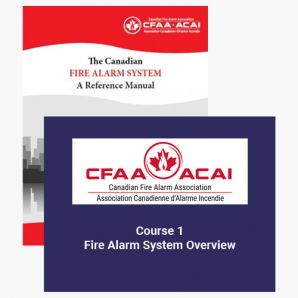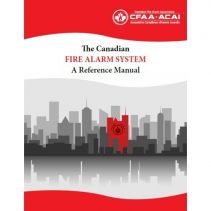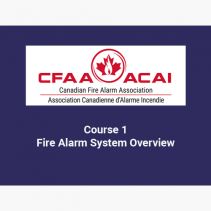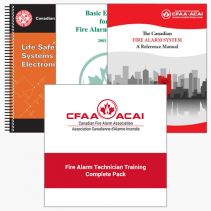
If ordering this course on behalf of another individual, please contact Orderline directly to place the order; this is required to ensure that the correct student information is captured for the student transcripts (ordering directly through the online cart may result in the card holder/ordering customer’s information being captured instead of the student information).
This pack includes:
1) Course 1 - Fire Alarm System Overview
2) The Canadian Fire Alarm System - A Reference Manual Pack
CFAA Course 1 - Fire Alarm System Overview and The Canadian Fire Alarm System - A Reference Manual Pack
More About This Product
If ordering this course on behalf of another individual, please contact Orderline directly to place the order; this is required to ensure that the correct student information is captured for the student transcripts (ordering directly through the online cart may result in the card holder/ordering customer’s information being captured instead of the student information).
Click here to buy the the Fire Alarm Technician Training Complete Pack and Save over $470.00!
This pack includes:
1) Course 1 - Fire Alarm System Overview
During the early 1980's the Canadian Fire Alarm Association established the Fire Alarm Technician Program, leading to personal registration as a fire alarm technician. It was created to provide training in the specialized area of fire alarm systems, thereby increasing the knowledge level of persons directly or indirectly involved in the fire alarm industry.
This educational program has been approved by various Authorities Having Jurisdiction nationwide and is now widely recognized within the industry.
This describes; the program intent, program structure, individual course content, qualifications for exemptions and CFAA Technician registration information. It is recommended that Trainees complete a minimum of 1500 hours of work experience to ensure that the CFAA Fire Alarm Trainee has acquired the knowledge and skills to successfully complete the Registration Exams. The CFAA has developed a CFAA Fire Alarm Trainee Log Book that provides a detailed reference for the kinds of training one should be trying to obtain to acquire the knowledge and skills required to successfully complete the Registration Exams. The CFAA Fire Alarm Trainee Log Book is NOT mandatory unless the Trainee is unsuccessful in completing the Registration Practical Exam on their second attempt. Some colleges provide fire alarm laboratory courses that are also recommended to those wishing to become Registered CFAA Fire Alarm Technicians. The work experience or lab training required by each individual will vary. Each individual must be well versed in all items contained within the CFAA Fire Alarm Trainee Logbook before proceeding. Once enough work experience or training has been obtained, the Trainee can then make arrangements to successfully complete the Registration Theory and then the Registration Practical Exam.
The combination of theory-based knowledge and workplace experience will together serve to increase the level of competence of fire alarm technicians within the industry.
Once an individual has completed the 5 courses in the CFAA Required Theory-Based Education they can become a Registered CFAA Fire Alarm Technician Trainee and then able to take both the CFAA Registration Theory Exam and Practical Exam to become a Registered Fire Alarm Technician. Each technician is issued a new photo ID with a unique registration number and the province of application. Technicians can also apply for Registration in other provinces with an additional fee for each province of registration.
Please note: this course expires 360 days from date of purchase.
2) The Canadian Fire Alarm System - A Reference Manual Pack
New Online PDF format
This new electronic format is now available for those looking for a more convenient alternative to the softcover copy. Access all of “The Canadian Fire Alarm System – A Reference Manual” content online or download an offline version for later use. Bookmarks and direct links are also included for easier navigation.
It is intended that this Manual be used for both courses. It is comprised of fourteen Units, beginning with historical notes and moving through the many components that make up today's fire alarm system. Related systems such as Voice Communication and Suppression are described in sufficient detail, along with their relation to the fire alarm.
The primary purpose of this manual is to prepare the candidate Technician for the field experience that usually follows a period of formal study. It is also suitable as a reference for courses presented to interest groups such as the Authorities Having Jurisdiction and building owners. It does not present manufacturer-specific detail or word for word repetition of Standards' text. Rather, this material is easily read and understood, accompanied by meaningful photographs and drawings.
Each Unit begins with a cover page outlining the contents of the Unit, and a list of the introductory material that is required for Course 1 study. For Course 5, all the material in the Manual requires study. Each Unit as well concludes with a series of review questions, that encourage further discussion especially when used in a classroom environment.
This manual makes reference to the 2010 and 2015 editions of the National Building and Fire Codes. For the most part, the ULC standards referenced are the 2013 and 2014 editions of S536, S537 and S524. The information drawn from these standards is presented in a format resembling the Standards' structure.
It is suggested that any learning institution using this Manual consider including the CFAA publication entitled "Fire Alarm Systems - A Laboratory Guide" as part of the course of study. A third publication "Fire Alarm Systems Trouble Shooting Guide, Vol 1", is also offered.
If ordering this course on behalf of another individual, please contact Orderline directly to place the order; this is required to ensure that the correct student information is captured for the student transcripts (ordering directly through the online cart may result in the card holder/ordering customer’s information being captured instead of the student information).
Click here to buy the the Fire Alarm Technician Training Complete Pack and Save over $470.00!
This pack includes:
1) Course 1 - Fire Alarm System Overview
During the early 1980's the Canadian Fire Alarm Association established the Fire Alarm Technician Program, leading to personal registration as a fire alarm technician. It was created to provide training in the specialized area of fire alarm systems, thereby increasing the knowledge level of persons directly or indirectly involved in the fire alarm industry.
This educational program has been approved by various Authorities Having Jurisdiction nationwide and is now widely recognized within the industry.
This describes; the program intent, program structure, individual course content, qualifications for exemptions and CFAA Technician registration information. It is recommended that Trainees complete a minimum of 1500 hours of work experience to ensure that the CFAA Fire Alarm Trainee has acquired the knowledge and skills to successfully complete the Registration Exams. The CFAA has developed a CFAA Fire Alarm Trainee Log Book that provides a detailed reference for the kinds of training one should be trying to obtain to acquire the knowledge and skills required to successfully complete the Registration Exams. The CFAA Fire Alarm Trainee Log Book is NOT mandatory unless the Trainee is unsuccessful in completing the Registration Practical Exam on their second attempt. Some colleges provide fire alarm laboratory courses that are also recommended to those wishing to become Registered CFAA Fire Alarm Technicians. The work experience or lab training required by each individual will vary. Each individual must be well versed in all items contained within the CFAA Fire Alarm Trainee Logbook before proceeding. Once enough work experience or training has been obtained, the Trainee can then make arrangements to successfully complete the Registration Theory and then the Registration Practical Exam.
The combination of theory-based knowledge and workplace experience will together serve to increase the level of competence of fire alarm technicians within the industry.
Once an individual has completed the 5 courses in the CFAA Required Theory-Based Education they can become a Registered CFAA Fire Alarm Technician Trainee and then able to take both the CFAA Registration Theory Exam and Practical Exam to become a Registered Fire Alarm Technician. Each technician is issued a new photo ID with a unique registration number and the province of application. Technicians can also apply for Registration in other provinces with an additional fee for each province of registration.
Please note: this course expires 360 days from date of purchase.
2) The Canadian Fire Alarm System - A Reference Manual Pack
New Online PDF format
This new electronic format is now available for those looking for a more convenient alternative to the softcover copy. Access all of “The Canadian Fire Alarm System – A Reference Manual” content online or download an offline version for later use. Bookmarks and direct links are also included for easier navigation.
It is intended that this Manual be used for both courses. It is comprised of fourteen Units, beginning with historical notes and moving through the many components that make up today's fire alarm system. Related systems such as Voice Communication and Suppression are described in sufficient detail, along with their relation to the fire alarm.
The primary purpose of this manual is to prepare the candidate Technician for the field experience that usually follows a period of formal study. It is also suitable as a reference for courses presented to interest groups such as the Authorities Having Jurisdiction and building owners. It does not present manufacturer-specific detail or word for word repetition of Standards' text. Rather, this material is easily read and understood, accompanied by meaningful photographs and drawings.
Each Unit begins with a cover page outlining the contents of the Unit, and a list of the introductory material that is required for Course 1 study. For Course 5, all the material in the Manual requires study. Each Unit as well concludes with a series of review questions, that encourage further discussion especially when used in a classroom environment.
This manual makes reference to the 2010 and 2015 editions of the National Building and Fire Codes. For the most part, the ULC standards referenced are the 2013 and 2014 editions of S536, S537 and S524. The information drawn from these standards is presented in a format resembling the Standards' structure.
It is suggested that any learning institution using this Manual consider including the CFAA publication entitled "Fire Alarm Systems - A Laboratory Guide" as part of the course of study. A third publication "Fire Alarm Systems Trouble Shooting Guide, Vol 1", is also offered.




